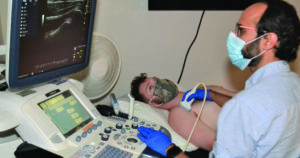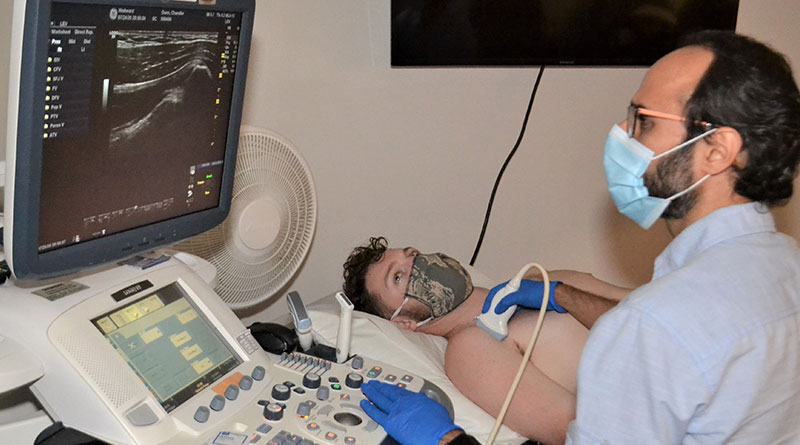
LEXINGTON Protein rich plasma, PRP, is a current topic of discussion. To gain more insight, we spoke with Danesh Mazloomdoost, MD, medical director of Wellward Regenerative Medicine. Mazloomdoost completed his medical degree and anesthesiology residency at John Hopkins Medical Institute. He completed pain medicine fellowships at MD Anderson Cancer Center in Houston and did subsequent post-fellowship training in regenerative medicine. Now, as the founder of Wellward Regenerative Medicine, Mazloomdoost serves as both a full-time clinician and administrator.
In clinical and in layman’s terms, what is PRP, Platelet Rich Plasma therapy?
In basic terms, PRP is a concentration of growth factors that tell the body how to repair an injury.
Since blood vessels course through every part of the body, injuries often cause capillary disruption and bleeding, even if on a very small scale. Once platelets stop moving and start coagulating, the injury stabilizes and enters the acute inflammatory stage. Platelets then start a slow release process of expressing the growth factors needed in repair. Within every platelet are large reservoirs of exosomes that contain a variety of growth factors. In various combinations, these growth factors are the chemical signals and cytokines that stimulate migration of mesenchymal stem cells to the area of damage and advance the inflammatory cascade that actually helps repair. Normally we think of inflammation as problematic and painful, but it is in fact needed for the repair process. For instance, edema gives mobility to cells and nutrients; inflammation sensitizes nerves to generate awareness and impose rest; the immune system starts breaking down unviable cells to make room for new cells.
PRP harnesses this reactive repair process and amplifies the body’s organic repair processes by creating a supra-physiologic expression of growth factors. We process the patient’s own blood in our customized lab to concentrate platelets and other growth factors far beyond what the body can express into an injury naturally. Then we reintroduce those factors into the specific regions of the body that either have scar tissue or need further stimulus for repair. There is no one-size-fits-all PRP solution. Each injury or tissue type needs a customized PRP mixture. Depending on need, our state-of-the art laboratory enables us to incorporate or remove leukocytes, fibrin, and other specialized proteins like Alpha-2-macroglobulin (A2M) – “sponges” for caustic inflammatory mediators. This process can yield higher volumes, better concentrations, and a more ideal mix of factors than the bedside automated devices on the market.
Can you give some background and history on the use and efficacy of PRP therapy?
Orthobiologics and interventional orthopedics date back to the 1930s with prolotherapy – a non-surgical technique to fortify damaged tissue, restore function, and reduce pain. The science involves a breadth of topics including understanding the cellular composition and requirements of tissue repair, the kinetic chain and how loads are distributed throughout the body, and the interplay of different tissue types to create stability and integrity of movement in a joint. While prolotherapy uses medications to augment tissue repair, orthobiologics like PRP and stem cell-derived therapies use biologic growth factors and cell signaling to modulate repair with even greater finesse. Even though the OrthoBiologics get greater public attention, they are only effective as an extension of prolotherapy techniques.

What is the current consensus about PRP? Is there one?
There is an ever-growing body of high-quality research proving the efficacy and cost-effectiveness of regenerative biologics, like PRP. There are numerous randomized controlled trials for every region of the body that have shown equivalency or superior outcomes to conventional treatments, with added advantages of faster recovery, lower invasiveness, and fewer complications. As this is a new field, a number of organizations are collaborating to uphold basic standards and advance research of regenerative biologics, and I believe a new specialty is being developed going by the title of regenerative medicine, interventional orthopedics, or orthobiologics.
The rising concern, however, is that without a formal certification, untrained clinicians may invest more in marketing than in training and take shortcuts that undermine outcomes or deliver subpar care. Across the country, clinics need to be scrutinized for scope of practice overreaches where mid-level practitioners, untrained physicians, or allied health partners are delivering these treatments, which are not unlike orthopedic or neurosurgery being done by untrained clinicians. These practices pose a serious risk to the field and could otherwise damage the credibility of a very promising field of medicine.

You’re an anesthesiologist, fellowship-trained in pain medicine. You have treated the sources of chronic and acute pain for years. Recently you have trained in regenerative medicine. How are you using PRP in your practice at Wellward Regenerative Medicine?
I trained at some of the best and most reputable institutions in the country, and yet, when I first started practicing using my conventional training, I saw futility. Across the country, pain clinics are revolving doors where patients are mired in a never-ending cycle of treatments that have a temporary reprieve but an expected relapse shortly thereafter. With steroid injections and pain medications, graduating a patient out of a pain clinic and back into mainstream life was an exception, not the rule. It was depressing.
One day, I had a very knowledgeable patient who asked me about prolotherapy, and I gave her the coined answer my attendings gave me – “inflammation is evil, suppressing inflammation is the only way, prolotherapy is voodoo…” But I was failing her, nonetheless, with the conventional approaches. So, two years out of training I started to question everything I was taught and deconstruct what I know. I began exploring all of the treatment pathways outside of the mainstream. The more I researched into orthobiologics and regenerative medicine, the more the science made sense. I started experimenting with a handful of patients and saw an immediate difference. It was a remarkable and undeniable improvement in outcomes. The answers were out there among different disciplines, but the fragmentation of healthcare had each falling short of the full picture.
PRP in and of itself, is not the game changer. Rather, bringing together the different disciplines that examine healing mechanisms at every level, understanding how damage perpetuates in the body, and aligning a cohesive multidisciplinary team that pools all of their singular advantages together is what has changed my practice. I now have hope that we can implement treatments that actually cure the conditions that cause pain, instead of just palliating them.
How do you see PRP being implemented by orthopedists and sports medicine doctors, currently and in the future?
We are at an inflection point, similar to arthroscopy versus open surgery or interventional cardiology versus CT surgery. Imaging tools and techniques continue to evolve, enabling physicians to visualize and access conditions with ever less invasiveness. While arthroscopy was a different skillset compared with open surgery, such is also the case with non-surgical orthobiologic cases, and this may pose a large-scale challenge in systemic adaption. The advantage of orthobiologics, however, make it a challenge worth pursuing. These solutions are modulating the body’s organic response to tissue repair in lieu of permanent hardware, sutures, or instrumentation. As the body changes with age, organic solutions are more forgiving to adjacent tissue and have the capacity for growth and adaptation. Regenerative medicine will never eliminate the need for surgery, but there are many conditions for which surgery as we know it will change and may even become obsolete. Even today, many clinicians are unaware of the non-surgical orthobiologic alternatives to conditions deemed as surgical necessity – torn or degenerative rotator cuff, ACL issues, menisci or labrum derangement, disc bulge/herniation or tear, and arthritis. These conditions and many more are demonstrating upwards of 75% resolution in our experience using non-surgical orthobiologic treatments.
What is the biggest misconception about PRP that you want to address?
Using orthobiologics effectively is not as simple as replacing steroids with a biologic product. To be effective, a clinician needs to understand the cellular composition of the orthobiologics, how they react to different tissue, and where to put the different factors, and have the skillset to confidently place the product in discrete tissues that may be no more than a few millimeters apart. These are often expensive procedures not covered by insurance, and the use is growing among many physicians and allied health providers. This raises a concern that profiteering may overwhelm judicious and well-trained use of the science. Already such problems have been evident in the illegal marketing of embryonic “stem cell injections” – which have never been shown to have viable stem cells despite their marketing – with unrealistic promises to patients. These inaccurate and misleading claims and untrained use of orthobiologic products violate the Hippocratic Oath in that patients are swindled out of substantial investment into failure-ridden treatments and erode their hope that their pain and suffering have a possible end. I’ve seen these tools applied by untrained practitioners working outside their scope of practice, and that concerns me; it’s not unlike having surgery by an untrained surgeon.


